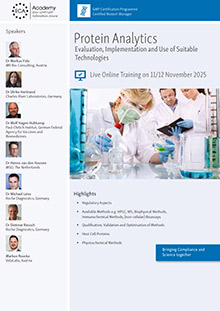Second Publication of PDA's Technical Report on Process Validation

Recommendation
5/6 February 2026
From time to time the Parenteral Drug Association (PDA) releases so-called "Technical Reports" (TR) on GMP topics. They provide useful and up-to-date information on the respective topic.
The newly published Technical Report No. 60 deals with the topic "Process Validation: A Life Cycle Approach". It has been published as corrected version as a few mistakes had been found in the first edition. The document contains 92 pages and is strongly influenced by the validation life cycle model of the FDA.
The report is divided into 9 chapters:
1. Introduction
2. Glossary of Terms
3. Stage 1 Process Design
4. Stage 2 Process Qualification
5. Stage 3 Continued Process Verification
6. Process Validation enabling Systems and Technology
7. Examples
8. Appendices
9. References
Chapter 4 on Process Qualification is particularly interesting and the part on qualification is mainly oriented on the document ASTM 2500-07 and on the ISPE guidelines. The subchapter on "Process Performance Qualification (PPQ)" expressly points out that the number of successful validation lots shouldn't be seen as purpose No. 1 for PPQ. In a deeper description it is even stated that it doesn't always make sense to use statistical approaches to determine the number of validation lots (i.e. when little API is available). A risk analysis relating to the results from stage 1 will then define the number of lots. In such cases, the results of enhanced sampling in stage 3 should ideally confirm the results from stage 2 - and 1. Statistical approaches are referred to in chapters 6 and 8. Chapter 4 also presents "Bracketing, Matrix und Family Approaches". The chapter ends with possible contents for a PPQ protocol and report.
According to the FDA Guidance for Industry on Process Validation, older products/ processes should be brought into the life cycle in stage 3. The Report provides support to this instruction in chapter 5 (continued process verification) with a flow chart on how to implement that.
Chapter 6 (process validation enabling systems and technology) mainly focuses on risk management (partly with very pragmatic examples), Design of Experiments (DoE), statistical process control (SPC), statistical sampling, PAT and Knowledge Management.
The appendices in chapter 8 are particularly interesting. They present methods to determine the number of validation lots and provide recommendation on the types of control charts (SPC).
Conclusion: the Technical Report is very extensive and mainly oriented on FDA's Guidance for Industry Process Validation: General Principles and Practices. The praxis examples are mainly interesting - particularly in chapter 7 which gives a compressed example of a validation life cycle of a biotech ("Large Molecule") and parenteral ("Small Molecule") product. Unfortunately, the Report is subject to a charge for non-members.





